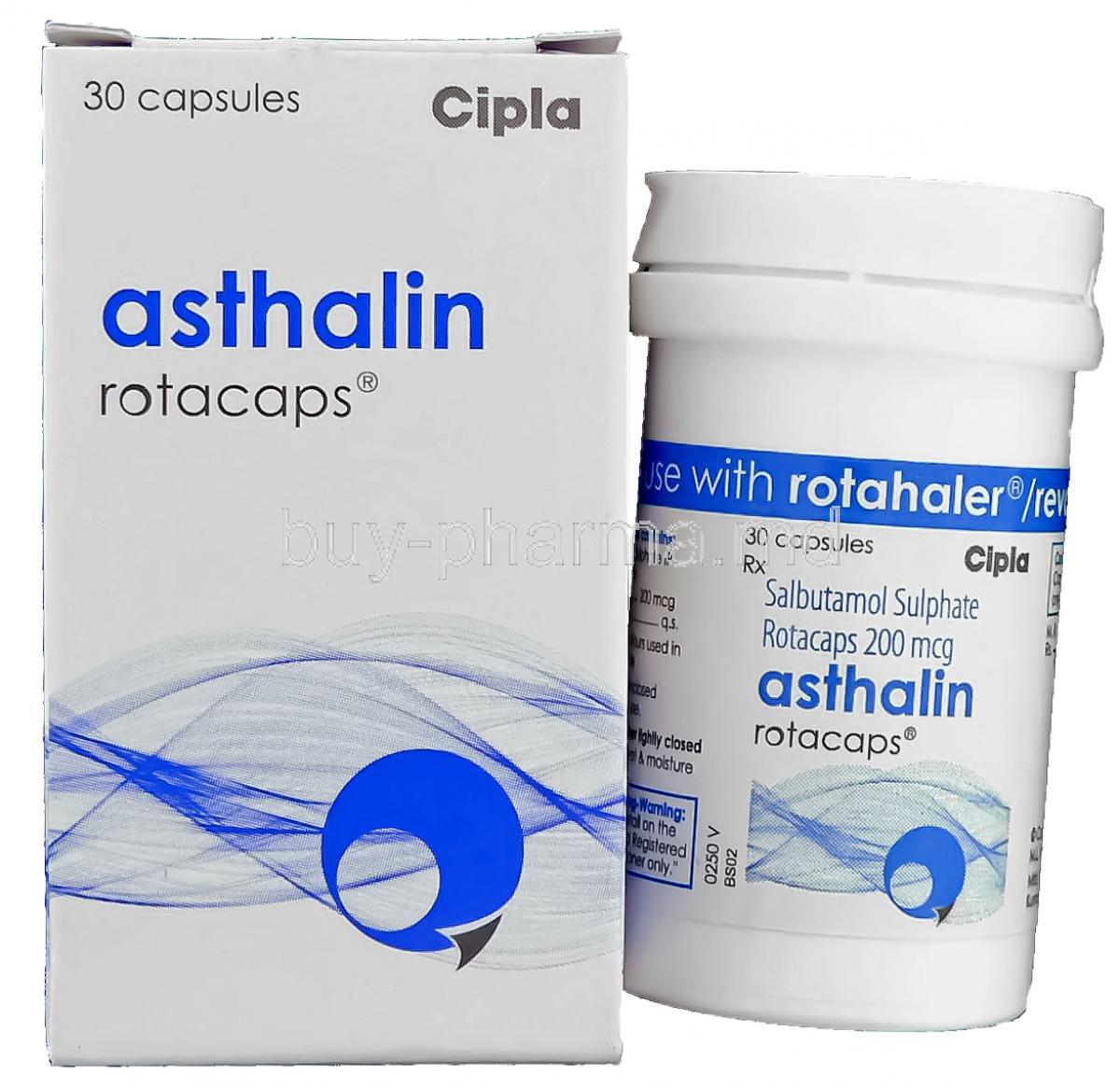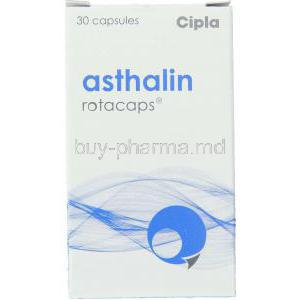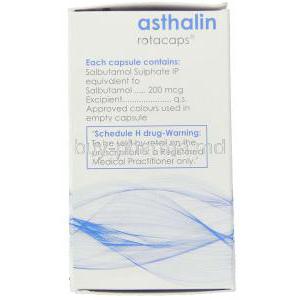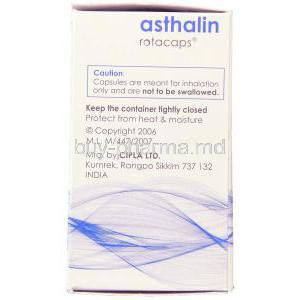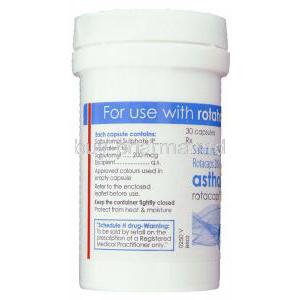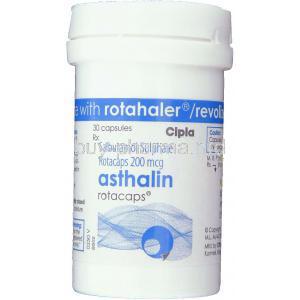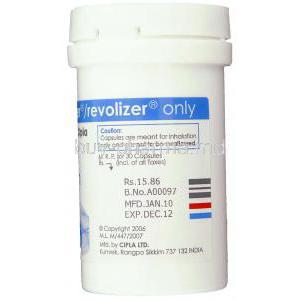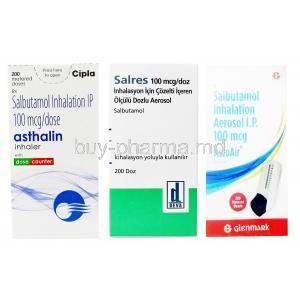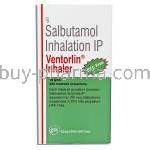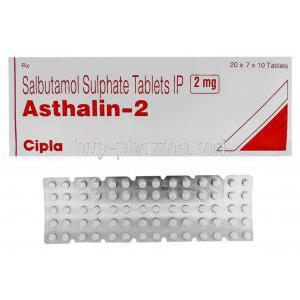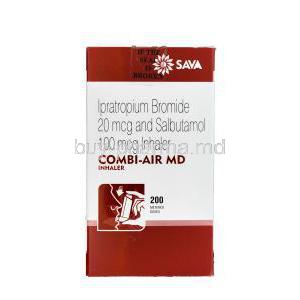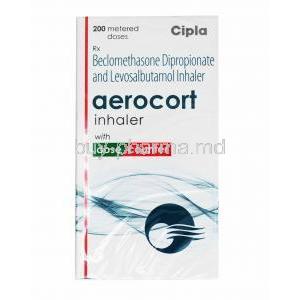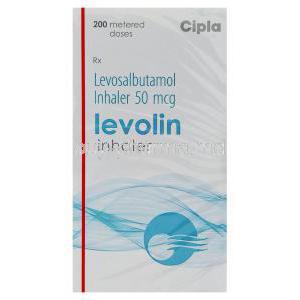Introduction
Overview of Asthalin Rotacap and its Role in Respiratory Therapy
Asthalin Rotacap is a widely prescribed medication designed to provide rapid relief from obstructive airway disorders. Delivered through an inhalation capsule system, it ensures direct action within the lungs, minimizing systemic exposure while maximizing respiratory benefit.
Classification as a Bronchodilator and β2-Adrenergic Agonist
This formulation belongs to the class of bronchodilators, specifically short-acting β2-adrenergic agonists (SABA). By stimulating receptors located in the bronchial smooth muscles, it exerts a potent bronchodilatory effect.
Importance in Managing Obstructive Airway Diseases
Asthalin Rotacap plays a pivotal role in conditions such as asthma and chronic obstructive pulmonary disease (COPD), where narrowed airways cause breathing distress. Its fast onset makes it an indispensable component of acute symptom control.
Composition and Formulation
Active Ingredient: Salbutamol Sulfate
The therapeutic efficacy of Asthalin Rotacap is derived from salbutamol sulfate, a selective β2-receptor agonist known for its prompt relief of bronchospasm.
Rotacap Delivery System: Inhalation Capsules and Device Compatibility
Each capsule is designed for use with a Rotahaler device, allowing precise delivery of medication deep into the airways. This system ensures optimal deposition within the lungs.
Excipients and Their Pharmaceutical Purpose
Inactive ingredients stabilize the formulation, enhance inhalation flow, and support uniform dispersion of the drug during inhalation therapy.
Salbutamol guaifenesin
The combination of salbutamol with guaifenesin is designed to relieve respiratory obstruction and improve pulmonary ventilation. Respiratory disorders where bronchospasm and excessive secretion of tenacious mucus are complicating factors, eg, bronchial asthma, chronic bronchitis and emphysema.
Asthalin vs albuterol
Asthalin and Albuterol are essentially the same medication; Asthalin is a brand name for the drug salbutamol (also known as albuterol), which is used as a bronchodilator to relieve symptoms of asthma and COPD by relaxing the muscles in the airways.
Salbutamol vs clenbuterol
Clenbuterol is an effective bronchodilator and, on the basis of molecular weight, about ten times more potent than salbutamol when given by aerosol.
Salbutamol vs ventolin
Salbutamol is the generic name of a medicine, while Ventolin is a well-known brand name for an inhaler containing salbutamol. Therefore, they are essentially the same medication; Ventolin and other generic salbutamol inhalers work in the same way and have the same active ingredient, differing only in cost and branding.
Mechanism of Action: How Asthalin Rotacap Works
β2-Adrenergic Receptor Stimulation and Smooth Muscle Relaxation
Salbutamol activates β2-adrenergic receptors on bronchial smooth muscles, leading to increased cyclic AMP production. This cascade culminates in muscle relaxation and bronchodilation.
Effect on Bronchial Passages and Airflow Improvement
- Rapid widening of constricted bronchial passages
- Enhanced airflow and oxygen delivery
- Reduction in wheezing and breathlessness
Onset and Duration of Action After Inhalation
Relief typically occurs within 5 to 15 minutes of inhalation, with effects lasting for 4 to 6 hours depending on the severity of the airway obstruction.
Pharmacokinetics and Metabolism of Salbutamol
Absorbed through pulmonary tissue, salbutamol undergoes hepatic metabolism and is excreted mainly in urine, with minimal systemic accumulation when used at recommended doses.
Approved Medical Uses
Management of Bronchospasm in Asthma
Asthalin Rotacap is indicated for the immediate relief of bronchospasm associated with asthma, offering quick reversal of acute episodes.
Relief of Chronic Obstructive Pulmonary Disease (COPD) Symptoms
Patients with COPD benefit from its bronchodilatory effect, which reduces persistent cough, wheezing, and shortness of breath.
Treatment of Exercise-Induced Bronchoconstriction
Pre-inhalation before physical exertion helps prevent airway tightening triggered by exercise.
Use in Acute Severe Asthma (Status Asthmaticus) Under Medical Supervision
In hospital settings, salbutamol may be employed as part of a structured regimen to manage severe asthma exacerbations, though under strict monitoring.
Off-Label and Investigational Uses
Potential Use in Hyperkalemia Management
Salbutamol may transiently lower serum potassium levels, providing adjunctive benefit in the acute management of hyperkalemia.
Adjunct Therapy in Premature Labor (Tocolytic Properties)
Its smooth muscle relaxing properties extend to uterine tissue, though this usage is limited and closely monitored.
Emergency Medicine Applications Beyond Asthma and COPD
Occasional off-label applications include emergency airway interventions where rapid bronchodilation is critical.
Asthalin Dosage and Administration
Recommended Inhalation Doses for Adults
Typical adult dosage involves one Rotacap as required, with frequency tailored to symptom severity and physician guidance.
Pediatric Dosing and Adjustments Based on Age/Weight
Children receive lower doses based on weight and response, with careful monitoring for overstimulation or cardiovascular effects.
Frequency of Administration and Maximum Daily Limits
Usage should not exceed prescribed limits. Overuse may diminish efficacy and heighten adverse effects.
Stepwise Inhalation Technique for Correct Use of Rotacaps
- Insert capsule into the device
- Pierce the capsule by twisting
- Inhale deeply and steadily to draw medication into the lungs
Missed Dose Guidance and Avoidance of Overdose
If a dose is missed, inhale as soon as remembered unless the next scheduled dose is near. Doubling doses to compensate is contraindicated.
Side Effects of Asthalin Rotacap
Common Side Effects
- Tremors, especially in the hands
- Headache and palpitations
- Nervousness, dizziness, or throat irritation
- Cough or dryness in the mouth
- salbutamol weight loss
Less Common and Serious Adverse Effects
- Hypokalemia leading to muscle cramps
- Cardiac effects including tachycardia and arrhythmias
- Paradoxical bronchospasm requiring immediate discontinuation
- Allergic or hypersensitivity reactions
Warnings and Important Precautions
Risk of Cardiovascular Complications in Predisposed Patients
Individuals with cardiac arrhythmias or ischemic heart disease must use Asthalin Rotacap cautiously.
Monitoring of Potassium Levels During Prolonged Use
Long-term use may reduce potassium, necessitating periodic blood monitoring in at-risk patients.
Avoidance of Excessive or Frequent Inhalations
Exceeding recommended frequency can induce tolerance, diminish efficacy, and increase systemic adverse effects.
Importance of Using Asthalin Rotacap Only as Prescribed
Self-adjustment of dosage without medical supervision can lead to adverse outcomes. Physician-directed use ensures safety and effectiveness.
Contraindications
Known Hypersensitivity to Salbutamol or Excipients
Asthalin Rotacap is contraindicated in individuals with documented hypersensitivity to salbutamol or any of its excipients. Hypersensitivity reactions may manifest as skin eruptions, bronchospasm, or in rare instances, anaphylaxis.
Severe Tachyarrhythmias and Unstable Cardiac Conditions
Patients with uncontrolled or severe tachyarrhythmias, ischemic heart disease, or unstable cardiac conditions should not use Asthalin Rotacap. The β2-agonist activity can exacerbate rhythm disturbances and compromise cardiovascular stability.
Relative Contraindications in Uncontrolled Hypertension
Uncontrolled hypertension is a relative contraindication. Stimulation of β2-receptors may elevate blood pressure and potentiate vascular complications in susceptible individuals.
Careful Administration in Special Populations
Elderly Patients
Elderly patients require meticulous assessment before prescribing Asthalin Rotacap. Age-related decline in cardiac reserve and renal clearance can amplify the drug’s systemic effects.
- Lower initiation doses are recommended.
- Polypharmacy risks increase the potential for adverse drug interactions.
- Enhanced monitoring for tremor, palpitations, or arrhythmias is necessary.
Pregnant Women and Nursing Mothers
Salbutamol should be used in pregnancy only if the anticipated benefits outweigh the potential risks. Although studies suggest relative safety, the absence of absolute certainty requires cautious judgment.
- Trace amounts of salbutamol may cross the placenta.
- Minimal quantities can be excreted in breast milk.
- A risk-benefit evaluation is critical for maternal asthma management to ensure both maternal and fetal well-being.
Pediatric Patients
Children are more susceptible to improper inhalation technique, which may reduce therapeutic benefit.
- Dosing must be adjusted according to body weight and age.
- Training in correct device use is essential for efficacy.
- Close supervision helps mitigate risks of overstimulation or paradoxical bronchospasm.
Drug and Food Interactions
Interaction with β-Blockers and Reduced Efficacy
Non-selective β-blockers antagonize the effects of salbutamol, potentially precipitating severe bronchospasm in asthmatic patients.
Concomitant Use with Xanthines, Diuretics, or Corticosteroids
Simultaneous administration with xanthines, loop diuretics, or corticosteroids may enhance hypokalemic effects, necessitating electrolyte monitoring.
Risk of Arrhythmias with MAO Inhibitors or Tricyclic Antidepressants
Combining Asthalin Rotacap with monoamine oxidase inhibitors or tricyclic antidepressants can increase the risk of cardiovascular side effects, including arrhythmias and hypertensive crises.
Alcohol Intake and Potential Impact on Drug Response
Alcohol consumption may exacerbate cardiovascular strain and diminish the overall therapeutic control of respiratory symptoms.
Overdosage and Emergency Management
Symptoms of Overdose: Chest Pain, Tremor, Hypertension, Arrhythmias
Excessive inhalation may lead to pronounced tremors, tachycardia, chest discomfort, hypertension, and arrhythmogenic events. Severe cases may progress to metabolic acidosis and hypokalemia.
Emergency Treatment Strategies and Supportive Measures
Management involves discontinuation of the drug, administration of cardio-selective β-blockers under careful monitoring, and correction of electrolyte imbalances. Supportive therapy such as oxygen supplementation may be required.
Importance of Immediate Medical Attention
Prompt medical evaluation is vital in overdose scenarios to prevent life-threatening complications.
Storage and Handling Precautions
Recommended Storage Conditions for Asthalin Rotacaps
Store at controlled room temperature, away from direct sunlight. Ideal storage is in a cool, dry environment to maintain potency.
Protecting Capsules from Moisture and Heat
Moisture and excessive heat can compromise the integrity of the capsule shell and reduce inhalation efficacy. Keep capsules in their original packaging until use.
Proper Handling and Disposal of Used Rotacaps
Used capsules should not be reused or ingested. Dispose of empty shells safely to prevent accidental exposure.
Device Cleaning and Maintenance Instructions
The Rotahaler device should be cleaned regularly with a dry cloth. Avoid rinsing with water to maintain device function and prevent clogging of medication pathways.
Asthalin Rotacap, Salbutamol FAQ
- What are asthalin rotacaps used for?
- What is rotacaps 200 mcg used for?
- Can asthalin reduce cough?
- Is asthalin a steroid?
- How many times can asthalin be taken?
- How to use Asthalin rotacap?
- What are the side effects of Asthalin?
- Is asthalin mucolytic?
- Is Asthalin for asthma only?
- Is asthalin rotacaps a steroid?
- Does asthalin increase blood pressure?
- When is the best time to take Asthalin?
- What precautions should be taken when using Asthalin?
- Is it ok to use asthalin for cough?
- Is asthalin harmful?
- How fast does Asthalin work?
- Does asthalin reduce phlegm?
- What are the side effects of Asthalin?
- What is salbutamol used for?
- Is salbutamol a beta-2-agonist?
- How quickly does salbutamol work?
- Is salbutamol safe to take?
- When not to use salbutamol?
- What are the common side effects of salbutamol?
- What drugs should not be taken with salbutamol?
- Does salbutamol stop coughing?
- Does salbutamol make it hard to sleep?
- Can salbutamol affect the heart?
What are asthalin rotacaps used for?
Asthalin Rotacaps is designed to alleviate symptoms of asthma and chronic obstructive pulmonary disease (COPD), including coughing, wheezing, and difficulty breathing. It should be taken consistently to ensure that the airways remain open at all times.
What is rotacaps 200 mcg used for?
It is used to alleviate symptoms of obstructive airway diseases such as asthma and chronic obstructive pulmonary disease.
Can asthalin reduce cough?
It offers fast relief from cough and typical cold symptoms such as a runny nose, blocked nose, sneezing, watery eyes, and congestion or nasal stuffiness.
Is asthalin a steroid?
No
How many times can asthalin be taken?
2-4 times daily
How to use Asthalin rotacap?
- Follow your doctor's directions regarding the dosage and timing of this medication.
- Hold the inhaler with the mouthpiece pointing downwards.
- Create a tight seal by placing your lips around the mouthpiece.
- Begin breathing slowly through your mouth and press down on the inhaler once.
What are the side effects of Asthalin?
It can lead to typical side effects like nausea, vomiting, restlessness, tremors (shakiness), headaches, muscle tightness, dryness or soreness in the throat, dizziness, sleepiness, palpitations (irregular heartbeat), nasal congestion (stuffy nose), cough, and an increased heart rate.
Is asthalin mucolytic?
Yes
Is Asthalin for asthma only?
The Asthalin Inhaler is a commonly used bronchodilator that offers rapid relief from asthma symptoms and various respiratory issues marked by bronchospasm.
Is asthalin rotacaps a steroid?
No
Does asthalin increase blood pressure?
Yes
When is the best time to take Asthalin?
- When you experience symptoms like coughing, wheezing, shortness of breath, or tightness in the chest
- If you anticipate engaging in an activity that may lead to breathlessness.
What precautions should be taken when using Asthalin?
Asthalin must only be used for inhalation, to be taken in through the mouth with an appropriate nebulizer, and must not be injected or swallowed
Is it ok to use asthalin for cough?
Yes
Is asthalin harmful?
No
How fast does Asthalin work?
5 minutes
Does asthalin reduce phlegm?
It thins and loosens mucus (phlegm), making it easier to expel through coughing.
What are the side effects of Asthalin?
- nausea
- vomiting
- restlessness
- tremors (shakiness)
- headache
- muscle tightness
- dryness or soreness in the throat
- dizziness, sleepiness
- palpitations (irregular heartbeat)
- nasal congestion (stuffy nose)
- cough
- increased heart rate.
What is salbutamol used for?
Salbutamol is used to alleviate symptoms of asthma and chronic obstructive pulmonary disease (COPD) such as coughing, wheezing, and shortness of breath. It's classified as a bronchodilator. It functions by relaxing the muscles in the airways leading to the lungs, making it easier to breathe.
Is salbutamol a beta-2-agonist?
Yes
How quickly does salbutamol work?
Treatment effects typically start in approximately 10-15 minutes, reaching their peak effect usually within 30 minutes.
Is salbutamol safe to take?
Yes
When not to use salbutamol?
Patients dealing with severe asthma, heart issues, diabetes, an overactive thyroid, high blood pressure, lung infections, arrhythmias, or low potassium levels should use salbutamol with caution.
What are the common side effects of salbutamol?
- Shakiness
- Headache
- Rapid heart rate
- Dizziness
- Feeling anxious.
What drugs should not be taken with salbutamol?
- Acetazolamide
- Loop diuretics
- Thiazides
Does salbutamol stop coughing?
Yes
Does salbutamol make it hard to sleep?
No
Can salbutamol affect the heart?
May increase the likelihood of cardiovascular diseases like coronary heart disease, cerebrovascular disease, and heart failure associated with asthma.

